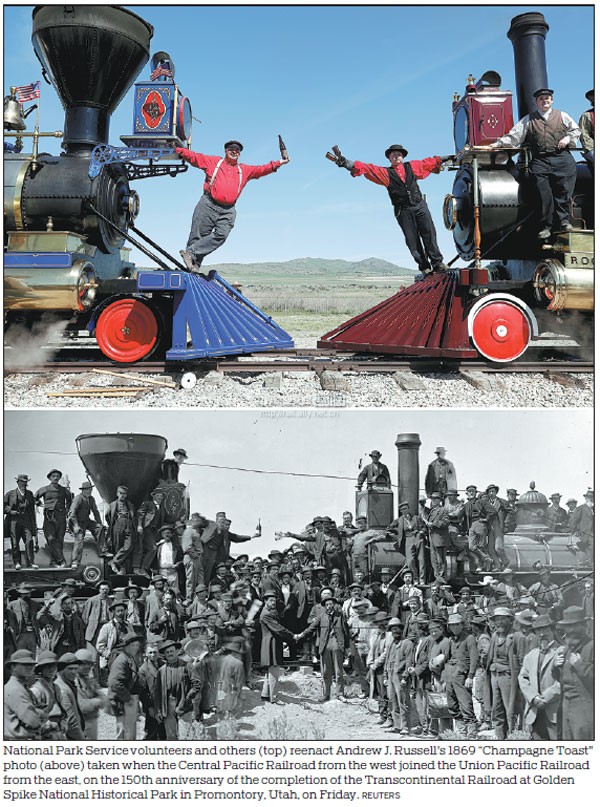US railroad's China connection
2019-05-13 09:14:01The Golden Spike's 150th anniversary celebration held at the Promontory Summit, Utah, on Friday, was a historic event for the United States. It was also an occasion to recall efforts of thousands of Chinese workers who were part of the project.
The Golden Spike is the ceremonial gold final spike driven by Leland Stanford, president of Central Pacific Railroad, to join the rails of the transcontinental railroad on May 10, 1869.
Between 1863 and 1869, more than 12,000 Chinese workers helped build the 912-mile transcontinental railroad that connects the eastern US rail network with the Pacific coast.
Even as they endured harsh working and living conditions, they blasted and chiseled 15 tunnels through the hard granite of the Sierra Nevada Mountains. Hundreds of them died.
For 72-year-old Siu Wong, a retired doctor from New Mexico, US, and a descendant of a Chinese railroad worker, the grand ceremony in Utah on Friday meant a lot.
Wong's grandfather was working on the railroad in California. She was among the 400 descendants who took part in the celebration.
"Ninety percent of Central Pacific Railroad workers were Chinese, but Chinese are not included in the photos in the US history books. I have noticed that there is more recognition and acknowledgement of the Chinese contribution," said Wong.
The White House issued a presidential message on Friday on the 150th anniversary of the transcontinental railroad, mentioning the contributions of especially 12,000 or more Chinese laborers.
"I have the unique and moving opportunity to fully acknowledge and recognize the contributions and sacrifices of these laborers during the construction of transcontinental railroad," US Secretary of Transportation Elaine Chao, whose parents are of Chinese descent, said at the ceremony.
The event drew an estimated 20,000 people to the historic ground in Utah, where two railroads joined their rails to form the transcontinental railroad.
For the first time, Chinese and other immigrants were incorporated in the momentous reenactment.
Chinese, along with Irish and other immigrant groups, were depicted in a musical performance titled As One, inspired by the Golden Spike era.
Connie Young Yu, whose great-grandfather was a foreman in the Central Pacific Railroad Company - the company that built the railroad eastward from Sacramento, California, to complete the western part of the first transcontinental railroad in the US - was invited to take the stage at the beginning of the ceremony.
Chinese Ambassador to the US, Cui Tiankai, in a video message, described the railroad as an "example of how the Chinese and American people can come together to get things done, and make the impossible possible".
Chinese railroad workers were among the first Chinese immigrants to the US. The event gave a chance to patriotic Chinese Americans from all parts of the country to be honored and feel more connected to the contribution made by their ancestors.
"I feel proud and very happy to be at this once-in-a-lifetime event," said Don Yee, a medical engineer from Hicksville in New York.
Yee drove all the way with his wife, Georgina, and friends to Utah for the ceremony. Yee is a member of the American Legion Auxiliary unit 291, which works to meet the needs of the country's veterans, military, and their families. His responsibilities include teaching new Chinese immigrants to better adapt to American culture and advocating patriotism and honor.
Olivia Hao, 31, and Ricky Ren, 32, both film makers from Beijing, participated in the celebration. They said they were working on a TV series on the historic event.
"The younger generation doesn't know much about this part of history; we are lucky to have joined the great event," said Olivia.
lindadeng@chinadailyusa.com

- Previous:Construction site of Guiyang-Nanning high-speed railway
- Next:最后一页
